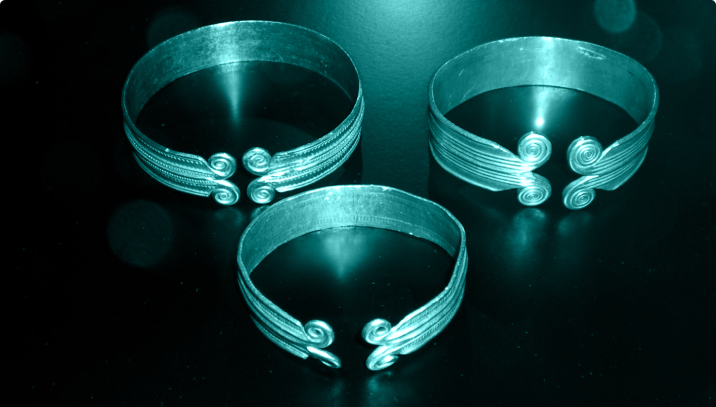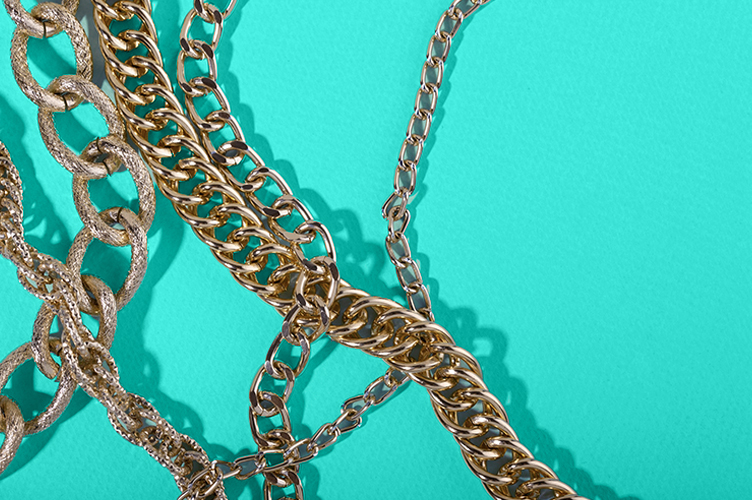The oldest jewelry ever found was discovered by archaeologists in 2014 in the Bizmoune Cave in Morocco. The beads they found are believed to be around 150,000 years old. At first, experts weren’t certain what the beads, made from shells, were for, but careful analysis showed that they were used to make jewelry. Scientific analysis was also used to properly date the beads. The discovery proved that throughout human history, people have sought out gemstones and crafted jewelry for a variety of purposes.
Paleolithic Period
Humans during the Paleolithic Period started to create more intricate jewelry with more advanced crafting techniques. Beads were used to express the artistic leanings of the person making them. This was possible in part because humans were creating more sophisticated tools that they could use when crafting beads from bones, shells, and clay. Examples of Paleolithic jewelry found at a burial site in modern France included necklaces made from deer teeth, shells, and fish bones arranged in symmetrical rows.
- Ancient Jewelry
- History of Beads: Upper Paleolithic Era
- Paleolithic Jewelry
- Archaeologists Discover Oldest Jewelry Ever, Shedding Light on Early Ways of Expressing Identity
Neolithic Period
Stoneworking technology advanced during the Neolithic Period to the point where stones could be drilled into and used as jewelry. At the same time, chisels became more sophisticated, and more intricate work on softer stones, bone, horn, and wood became possible. Also during this period, trade between neighboring groups sprang up. Not only were physical pieces of jewelry traded between groups, but so was knowledge about crafting techniques. Social status also became more defined in this era, and jewelry was one way that people showed off their status.
- Neolithic Bracelet
- Jewelry Styles Suggest Northern Europeans Resisted Farming
- Myths, Legends, and History in Neolithic and Nuragic Jewelry Pieces
- Neolithic People in the Near East Made Jewelry Out of Human Teeth
Ancient Egyptians
Humans have occupied the Nile Valley for more than 100,000 years. Early residents of this area crafted jewelry from animal teeth, stone, bone, ivory, and shells. Around 4000 B.C.E., the Badarian people who lived here had a belief in resurrection, and this led to the practice of burying the dead with things they would need for the afterlife. Jewelry was made specifically for this purpose.
- Egyptian Jewelry: A Window Into Ancient Culture
- Sacred Adornment: Jewelry as Belief in Ancient Egypt
- The Jeweler in Ancient Egypt
- All That Glitters: Gold Jewelry in Ancient Egypt
Ancient Chinese
People living close to the Yangtze River developed the first ancient Chinese jewelry. Even the earliest Chinese jewelry was crafted with symbolism and represented elements of Chinese beliefs and culture. Early traditional jewelry featured images of flowers, animals, and other natural elements. This jewelry was often made as a protective talisman instead of simply as ornamentation.
- The Role of Jewelry in Ancient Chinese Culture
- Unraveling the Ancient Riddles of Chinese Jewelry
- More Than Jade for Beauty: A Guide to Traditional Chinese Jewelry
Ancient Celts
The Iron Age led to many technological advances. Celtic people invented brooches that could be used to fasten clothing but were also used decoratively. They were made of iron, gold, bronze, or silver. It was rare for Celts to make rings during this period, but they crafted increasingly intricate bracelets. Most of these bracelets were made using the lost wax technique. The metals were then decorated with glass and enamel. Celtic people were particularly fond of jewelry decorated with red enamel.
Ancient Greeks
During the Hellenistic period in Greece, they began making a variety of types of jewelry, including thigh bands, rings, diadems, bracelets, earrings, and armbands. The Greeks in this period also really loved matched sets of bracelets and other jewelry items. The Greeks also loved gemstones, including carnelian, agate, and emerald. Much like other civilizations, the Greeks also used colored enamels to decorate their jewelry. Greeks passed along jewelry as family heirlooms, and some pieces were made to be offered to the gods at their temples. The Greeks also buried jewelry with their dead.
- The Gift of Jewelry Was an Ancient Love Language
- History of Jewelry: Ancient Greece and Mediterranean
- The Fascinating History of Ancient Greek Jewelry
- Adornments: Jewelry and More
Ancient Romans
Ancient Roman jewelry shows the influence of other cultures, like the Greeks and Egyptians. For example, the design of the Herakles knot shows the influence of both Egyptian and Greek jewelry. This design was used in jewelry to protect the wearer from evil spirits. When Augustus became emperor in 27 B.C.E., a time of peace known as the Pax Romana began. During this era, glass jewelry became very popular. The vast size of the Roman Empire gave Roman citizens access to precious gemstones like emeralds, sapphires, and diamonds to use in their jewelry.






